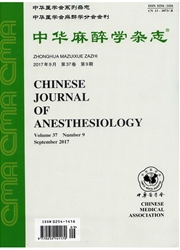

 中文摘要:
中文摘要:
目的评价脊髓小胶质细胞CC趋化因子受体2(CCR2)在大鼠骨癌痛维持中的作用。方法健康雌性未交配sD大鼠50只,2月龄,体重160-180g,采用随机数字表法,将其分为5组(n=10):假手术组(I组)、假手术+RSl02895(CCR2拮抗剂)组(Ⅱ组)、骨癌痛组(Ⅲ组)、骨癌痛+DMSO组(Ⅳ组)、骨癌痛+RSl02895组(V组)。左侧胫骨干骺端骨髓腔内接种Walker256乳腺癌细胞制备大鼠骨癌痛模型。手术后10.12d,1I组和V组分别鞘内注射3μg/RSl02895 10μl,IV组鞘内注射DMSO 10μl,I组和Ⅲ组鞘内注射生理盐水10μl,1次/d。手术前1d、术后3、6、9、10、11、12d时测定机械痛阈,术后12d痛阈测定后,取L4-6脊髓组织,采用免疫组织化学法测定脊髓背角小胶质细胞激活标记物(OX-42)水平,采用ELISA法测定脊髓IL-lβ、IL-6及TNF-α的含量。结果与I组比较,Ⅲ组、Ⅳ组、V组术后6-12d时机械痛阈降低,OX-42阳性细胞数、脊髓IL-lβ、IL-6及TNF-a含量升高(P〈0.01),Ⅱ组上述指标差异无统计学意义(P〉0.05);与Ⅲ组比较,V组术后10-12d时机械痛阈升高,OX-42阳性细胞数、脊髓IL-lβ、IL-6及TNF-a含量降低(P〈0.01),Ⅳ组上述指标差异无统计学意义(P〉0.05)。结论脊髓小胶质细胞CCR2参与大鼠骨癌痛的维持,其机制可能与激活小胶质细胞从而促进炎性细胞因子释放有关。
 英文摘要:
英文摘要:
Objective To evaluate the role of spinal microglial C-C chemokine receptor type 2 (CCR2) in the maintenance of bone cancer pain (BCP) in rats. Methods Fifty unmated female Sprague-Dawley rats, aged 2 months, weighing 160-180 g, were randomly divided into 5 groups (n = 10 each): sham operation group (group I ), sham operation + RS102895 (CCR2 antagonist) group (group II ), BCP group (group m ), BCP + dimethyl sulfoxide ( DMSO ) group ( group IV ), and BCP + RS102895 group ( group V ). The rats were anesthetized with intraperitoneal chloral hydrate. BCP was induced by intra-tibial inoculation of 1 × 10^5 Walker 256 mammary gland carcinoma cells into the medullary cavity of the left tibial metaphysis. On 10-12 days after operation, 3 μg/μl RSI02895 10 μl was injected intrathecally once a day in Ⅱ and V groups, 10% DMSO 10μl was injected intrathecally once a day in IV group, and normal saline 10 μlwas injected intrathecally once a day in I and m groups. Mechanical paw withdrawal threshold was measured at 1 day before operation and 3, 6, 9, 10, 11 and 12 days after operation. After measurement of pain threshold at day 12 after operation, the lumbar segments ( I4-6 ) of the spinal cord were removed for determination of the level of ox-42 (spinal microglial activation marker) (by immuno-histochemistry) and contents of ILl-β, IL-6 and TNF-α (by ELISA) .Results Compared with group I , mechanical paw withdrawal threshold was significantly decreased at 6-12 days after operation, the number of ox-42 positive cells and contents of ILI-β, IL-6 and TNF-α were increased in Ⅲ , Ⅳ and V groups, and no significant change was found in the parameters mentioned above in group Ⅱ . Compared with group Ⅲ , mechanical paw withdrawal threshold was significantly increased at 10-12 days after operation, the number of ox-42 positive cells and contents of ILI-β, IL-6 and TNF-α were decreased in group V , and no significant change was found in the parameters
 同期刊论文项目
同期刊论文项目
 同项目期刊论文
同项目期刊论文
 Activation of spinal TDAG8 and its downstream PKA signaling pathway contribute to bone cancer pain i
Activation of spinal TDAG8 and its downstream PKA signaling pathway contribute to bone cancer pain i P2X4 Receptor in the Dorsal Horn Partially Contributes to Brain-Derived Neurotrophic Factor Oversecr
P2X4 Receptor in the Dorsal Horn Partially Contributes to Brain-Derived Neurotrophic Factor Oversecr Minocycline-induced reduction of brain-derived neurotrophic factor expression in relation to cancer-
Minocycline-induced reduction of brain-derived neurotrophic factor expression in relation to cancer- P2Y1 purinoceptor inhibition reduces extracellular signal-regulated protein kinase 1/2 phosphorylati
P2Y1 purinoceptor inhibition reduces extracellular signal-regulated protein kinase 1/2 phosphorylati Involvement of CX3CR1 in bone cancer pain through the activation of microglia p38 MAPK pathway in th
Involvement of CX3CR1 in bone cancer pain through the activation of microglia p38 MAPK pathway in th 期刊信息
期刊信息
